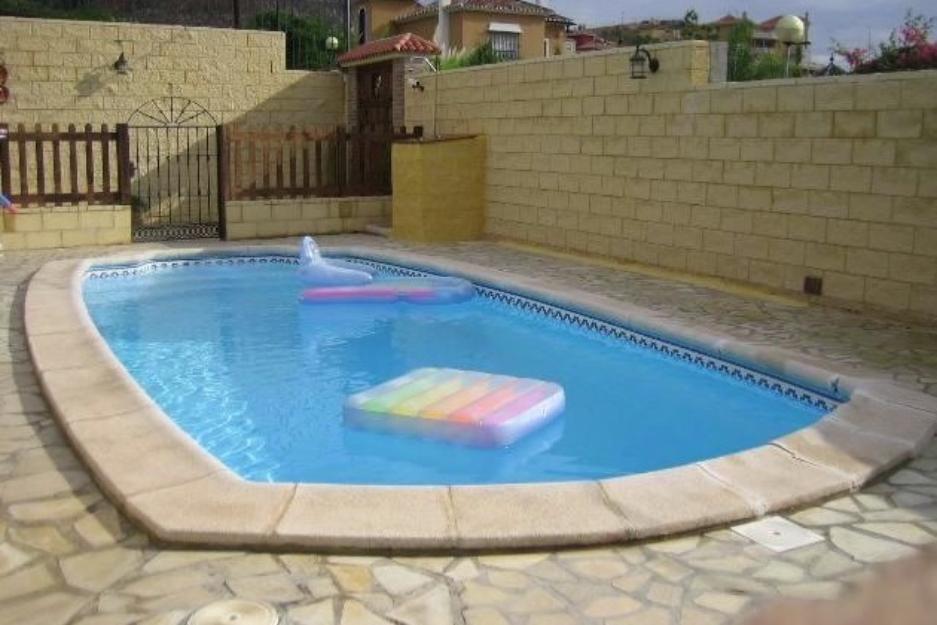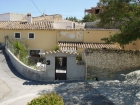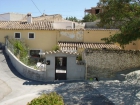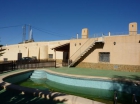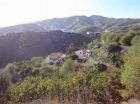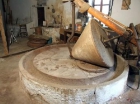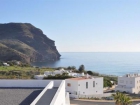una sola planta rincon 2013_sep
Categoría: Viviendas - Locales
Subcategoría: Piso - Casa en venta
Subcategoría: Piso - Casa en venta
Precio:
475€
- o -
Contactar al proveedor
Dormitorios: 4
Cuartos de baño: 3
Metros Cuadrados: 500
Amueblado: No
Mascotas: No
Comisión Inmobiliaria: No
ref 29
Villa on one floor, with pool in Rincon de la Victoria.
Detached villa with 500 m2 plot with sea and 160 m2 with 3 bedrooms, 2 bathrooms. Fantastic villa in Rincon de la victoria with private pool and perimeter wall. Maximum privacy. Bars on ground floor. Equipped kitchen. Bedrooms with wardrobes. The property also has a separate guest studio with a bedroom and a bathroom. Outdoor Barbeque on porch. The villa has air conditioning and heating, separate kitchen, living room with fireplace. No community fees. Year of construction 2005. www.kinos.es sale on one floor villas on the Costa del Sol Attractions in the area: La Cueva del Tesoro is located on one of the Cantales, or small cliffs that shaped limestone outcrops of the Jurassic era sea overlook this part of the Mediterranean coast. The sea is the main agent of erosion that has contributed to the formation of the present relief of Cantales. Over the millennia have been causing the caves and cliffs that are now so characteristic of this landscape. Rincón de la Victoria has one of the most unique caves of marine origin which are known in the world. It is the only of its kind on the European continent; the other two were discovered in Asia and Central America. The sea formed typical underwater caves galleries with columns and gorges that are the basis of the Cueva del Tesoro. Later, after the area emerged above the sea, fresh water leaks were forming stalactites and stalagmites, cave themselves from land erosion and fresh water. The cave is mostly known for the legend that surrounds it, the existence of a hidden gem in one of its caves during the Arab era treasure. This tradition is reflected in the writings of the seventeenth century by Fray Antonio Agustín de Milla and Suazo. The treasure was hidden by the Emperor of the Almoravids Tasufin ibn Ali in the twelfth century. Morphological characteristics of the Cueva del Tesoro From the archaeological point of view has a great importance for having found traces of Palaeolithic (Solutrean) and Bronze Age. The underground complex of La Cueva del Tesoro, also known as Fig Tree Cave, consists of several cavities possessing rock art samples. Focusing on the Cueva del Tesoro, I must say you have a typical limestone cave formations originated in the deep sea. The action of currents and waves makes them go eroding the softer parts and remain in columns and veins of the strongest limestone. Later, when the land emerged, fresh water leaks have created some stalactites and stalagmites. However, this is the least significant of the cave. La Cueva del Tesoro during its history La Cueva del Tesoro has been linked to many legends and historical facts relating to the alleged treasure believed still hiding inside. From studies of D. Manuel Laza, enthusiastic teacher and student of the cave, we know the history of the cave at different times. Also retained its "Excavations Papers" where we are informed of the archaeological work carried out by him. The oldest data we have from the Treasure Trove and Legend of the Five Kings back to the eighteenth century. A local illustrated, Christopher D. Medina Conde, published in 1789, under the pseudonym of Cecilio García de la Lena, the work entitled "Historical Malagueñas Talk". According to this work, was used Fig Tree Cave (Cueva del Tesoro current) in the year 86 BC by Marcus Crassus to take refuge for eight months when he was persecuted by Marius and Cinna. The tradition of Marcus Crassus refuge in the cave is older because the Count's own Medina collected from a previous author, the late seventeenth century, and also mentions the treasure. These Fray Antonio Agustín de Milla and Suazo.La tradition treasure and his quest to present It's ancient oral and written tradition that includes the existence of a hidden during the Arab era in Fig Tree Cave treasure. This tradition is already reflected in the work of Fray Antonio Agustín de Milla and Suazo (XVII Century) According to D. Manuel Laza, this treasure was hidden by the emperor commanded the Almoravids Tasufin ibn Ali in the twelfth century. This is based on some findings and analysis of the sources of the Arab period in Spain. The treasure has had various search engines in the last three centuries. The story of Swiss who gave name to the cave for years is as follows. Antonio Nari attracted to the Legend of the Five Kings Moors came to Malaga in the early nineteenth century and set out to find the treasure of the Fig Tree Cave. Various writers of the time attest to his tragic death, shattered by the explosion of a borehole in 1847. A legend of terror and mystery swept through the area. During the night wandering in torment his soul for the wilds of El Cantal Alto. Many neighbors testified terrifying apparitions. This used gunpowder to open new galleries and was the discoverer of a part of the cave which was plugged and hidden for centuries. D. Manuel Laza believed in the existence of the treasure and the findings related to it are: a) Finding the eighteenth century a lot of garnets (according to the account of Medina Conde) b) Appearance in the vicinity of a six almorávides tesorillo gold coins from the time of Yusuf ibn Tasufin. This finding and the following are from the time of Manuel Laza. c) The breakage and disappearance of normal archaeological levels throughout prehistoric cave in the center part in one of the rooms in the Cave (Court of the Virgin). d) Finding of torques or three doors that lead to the same room of the cave and had been artificially capped with large stones. After removing these stones appeared with them remnants of Arab glazed ceramic, similar to that which appeared in the nearby Arab town of Bezmiliana. e) In the same room a pit full of large stones and clay was found. The position of these materials did think that it was an artificial filler. These findings and subsequent Manuel Laza did believe that he was very close to the treasure and research following anyone ever find. Archaeological finds The remains found in these excavations, of which an example can be seen in the National Archaeological Museum in Madrid, we classify them into the following groups: a) under the Pottery Neolithic Cave. b) lithic industry. c) Human Remains. d) Animal remains even Upper Paleolithic. Shrine of the Goddess Noctiluca Regarding the Treasure Cave is a series of legends and curiosities that are part of the tradition of these fishing villages on the Mediterranean coast. Among them include the following: According to studies by D. Manuel Laza, is situated in the old Cave Shrine of the Goddess Noctiluca. "It is reasonable to think that the Phoenician settlers founded the city put under the patronage of the ancient goddess, who was worshiped on these shores ..." This goddess was the queen of heaven and earth. Hence the city of Malaga it was called Malacca, ie queen. We said that we called Festo Avieno numen protector of these costs Noctiluca. It is the same Mediterranean goddess worshiped from prehistoric times to all peoples located on the shore of Mare Nostrum. His character and attributes have been studied extensively. Goddess of fertility, life and death. Its name changes according to the languages of the people who venerated. Their temples were the caves of the mountains. His image in the heavens was the moon in its different phases and earth his picture was a rock just a betilo.
Cuartos de baño: 3
Metros Cuadrados: 500
Amueblado: No
Mascotas: No
Comisión Inmobiliaria: No
ref 29
Villa on one floor, with pool in Rincon de la Victoria.
Detached villa with 500 m2 plot with sea and 160 m2 with 3 bedrooms, 2 bathrooms. Fantastic villa in Rincon de la victoria with private pool and perimeter wall. Maximum privacy. Bars on ground floor. Equipped kitchen. Bedrooms with wardrobes. The property also has a separate guest studio with a bedroom and a bathroom. Outdoor Barbeque on porch. The villa has air conditioning and heating, separate kitchen, living room with fireplace. No community fees. Year of construction 2005. www.kinos.es sale on one floor villas on the Costa del Sol Attractions in the area: La Cueva del Tesoro is located on one of the Cantales, or small cliffs that shaped limestone outcrops of the Jurassic era sea overlook this part of the Mediterranean coast. The sea is the main agent of erosion that has contributed to the formation of the present relief of Cantales. Over the millennia have been causing the caves and cliffs that are now so characteristic of this landscape. Rincón de la Victoria has one of the most unique caves of marine origin which are known in the world. It is the only of its kind on the European continent; the other two were discovered in Asia and Central America. The sea formed typical underwater caves galleries with columns and gorges that are the basis of the Cueva del Tesoro. Later, after the area emerged above the sea, fresh water leaks were forming stalactites and stalagmites, cave themselves from land erosion and fresh water. The cave is mostly known for the legend that surrounds it, the existence of a hidden gem in one of its caves during the Arab era treasure. This tradition is reflected in the writings of the seventeenth century by Fray Antonio Agustín de Milla and Suazo. The treasure was hidden by the Emperor of the Almoravids Tasufin ibn Ali in the twelfth century. Morphological characteristics of the Cueva del Tesoro From the archaeological point of view has a great importance for having found traces of Palaeolithic (Solutrean) and Bronze Age. The underground complex of La Cueva del Tesoro, also known as Fig Tree Cave, consists of several cavities possessing rock art samples. Focusing on the Cueva del Tesoro, I must say you have a typical limestone cave formations originated in the deep sea. The action of currents and waves makes them go eroding the softer parts and remain in columns and veins of the strongest limestone. Later, when the land emerged, fresh water leaks have created some stalactites and stalagmites. However, this is the least significant of the cave. La Cueva del Tesoro during its history La Cueva del Tesoro has been linked to many legends and historical facts relating to the alleged treasure believed still hiding inside. From studies of D. Manuel Laza, enthusiastic teacher and student of the cave, we know the history of the cave at different times. Also retained its "Excavations Papers" where we are informed of the archaeological work carried out by him. The oldest data we have from the Treasure Trove and Legend of the Five Kings back to the eighteenth century. A local illustrated, Christopher D. Medina Conde, published in 1789, under the pseudonym of Cecilio García de la Lena, the work entitled "Historical Malagueñas Talk". According to this work, was used Fig Tree Cave (Cueva del Tesoro current) in the year 86 BC by Marcus Crassus to take refuge for eight months when he was persecuted by Marius and Cinna. The tradition of Marcus Crassus refuge in the cave is older because the Count's own Medina collected from a previous author, the late seventeenth century, and also mentions the treasure. These Fray Antonio Agustín de Milla and Suazo.La tradition treasure and his quest to present It's ancient oral and written tradition that includes the existence of a hidden during the Arab era in Fig Tree Cave treasure. This tradition is already reflected in the work of Fray Antonio Agustín de Milla and Suazo (XVII Century) According to D. Manuel Laza, this treasure was hidden by the emperor commanded the Almoravids Tasufin ibn Ali in the twelfth century. This is based on some findings and analysis of the sources of the Arab period in Spain. The treasure has had various search engines in the last three centuries. The story of Swiss who gave name to the cave for years is as follows. Antonio Nari attracted to the Legend of the Five Kings Moors came to Malaga in the early nineteenth century and set out to find the treasure of the Fig Tree Cave. Various writers of the time attest to his tragic death, shattered by the explosion of a borehole in 1847. A legend of terror and mystery swept through the area. During the night wandering in torment his soul for the wilds of El Cantal Alto. Many neighbors testified terrifying apparitions. This used gunpowder to open new galleries and was the discoverer of a part of the cave which was plugged and hidden for centuries. D. Manuel Laza believed in the existence of the treasure and the findings related to it are: a) Finding the eighteenth century a lot of garnets (according to the account of Medina Conde) b) Appearance in the vicinity of a six almorávides tesorillo gold coins from the time of Yusuf ibn Tasufin. This finding and the following are from the time of Manuel Laza. c) The breakage and disappearance of normal archaeological levels throughout prehistoric cave in the center part in one of the rooms in the Cave (Court of the Virgin). d) Finding of torques or three doors that lead to the same room of the cave and had been artificially capped with large stones. After removing these stones appeared with them remnants of Arab glazed ceramic, similar to that which appeared in the nearby Arab town of Bezmiliana. e) In the same room a pit full of large stones and clay was found. The position of these materials did think that it was an artificial filler. These findings and subsequent Manuel Laza did believe that he was very close to the treasure and research following anyone ever find. Archaeological finds The remains found in these excavations, of which an example can be seen in the National Archaeological Museum in Madrid, we classify them into the following groups: a) under the Pottery Neolithic Cave. b) lithic industry. c) Human Remains. d) Animal remains even Upper Paleolithic. Shrine of the Goddess Noctiluca Regarding the Treasure Cave is a series of legends and curiosities that are part of the tradition of these fishing villages on the Mediterranean coast. Among them include the following: According to studies by D. Manuel Laza, is situated in the old Cave Shrine of the Goddess Noctiluca. "It is reasonable to think that the Phoenician settlers founded the city put under the patronage of the ancient goddess, who was worshiped on these shores ..." This goddess was the queen of heaven and earth. Hence the city of Malaga it was called Malacca, ie queen. We said that we called Festo Avieno numen protector of these costs Noctiluca. It is the same Mediterranean goddess worshiped from prehistoric times to all peoples located on the shore of Mare Nostrum. His character and attributes have been studied extensively. Goddess of fertility, life and death. Its name changes according to the languages of the people who venerated. Their temples were the caves of the mountains. His image in the heavens was the moon in its different phases and earth his picture was a rock just a betilo.

